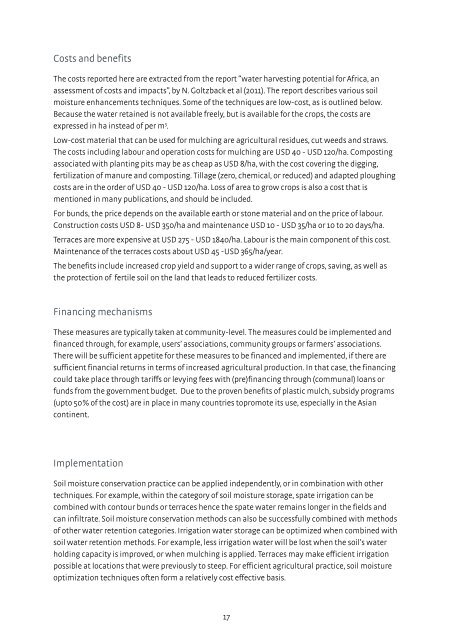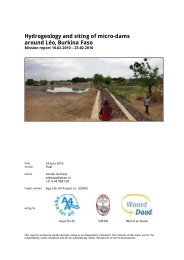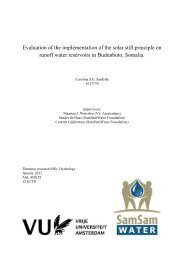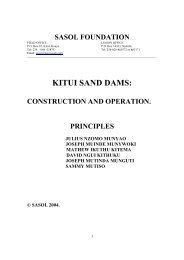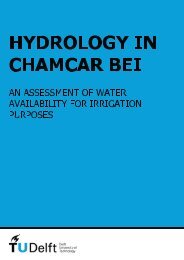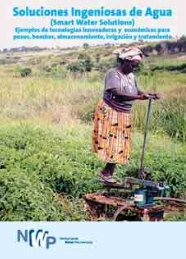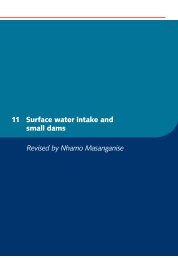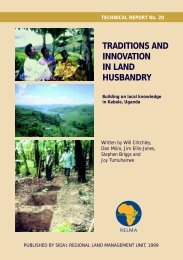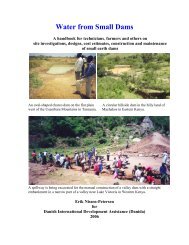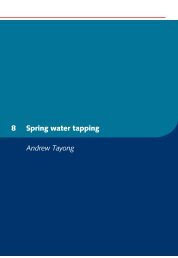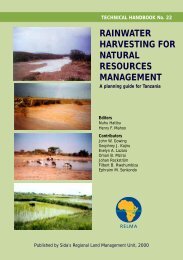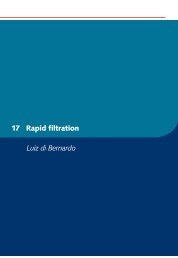the costs and benefits of water buffering
the costs and benefits of water buffering - Aqua for All
the costs and benefits of water buffering - Aqua for All
- No tags were found...
Create successful ePaper yourself
Turn your PDF publications into a flip-book with our unique Google optimized e-Paper software.
Costs <strong>and</strong> <strong>benefits</strong>The <strong>costs</strong> reported here are extracted from <strong>the</strong> report “<strong>water</strong> harvesting potential for Africa, anassessment <strong>of</strong> <strong>costs</strong> <strong>and</strong> impacts”, by N. Goltzback et al (2011). The report describes various soilmoisture enhancements techniques. Some <strong>of</strong> <strong>the</strong> techniques are low-cost, as is outlined below.Because <strong>the</strong> <strong>water</strong> retained is not available freely, but is available for <strong>the</strong> crops, <strong>the</strong> <strong>costs</strong> areexpressed in ha instead <strong>of</strong> per m 3 .Low-cost material that can be used for mulching are agricultural residues, cut weeds <strong>and</strong> straws.The <strong>costs</strong> including labour <strong>and</strong> operation <strong>costs</strong> for mulching are USD 40 - USD 120/ha. Compostingassociated with planting pits may be as cheap as USD 8/ha, with <strong>the</strong> cost covering <strong>the</strong> digging,fertilization <strong>of</strong> manure <strong>and</strong> composting. Tillage (zero, chemical, or reduced) <strong>and</strong> adapted ploughing<strong>costs</strong> are in <strong>the</strong> order <strong>of</strong> USD 40 - USD 120/ha. Loss <strong>of</strong> area to grow crops is also a cost that ismentioned in many publications, <strong>and</strong> should be included.For bunds, <strong>the</strong> price depends on <strong>the</strong> available earth or stone material <strong>and</strong> on <strong>the</strong> price <strong>of</strong> labour.Construction <strong>costs</strong> USD 8- USD 350/ha <strong>and</strong> maintenance USD 10 - USD 35/ha or 10 to 20 days/ha.Terraces are more expensive at USD 275 - USD 1840/ha. Labour is <strong>the</strong> main component <strong>of</strong> this cost.Maintenance <strong>of</strong> <strong>the</strong> terraces <strong>costs</strong> about USD 45 -USD 365/ha/year.The <strong>benefits</strong> include increased crop yield <strong>and</strong> support to a wider range <strong>of</strong> crops, saving, as well as<strong>the</strong> protection <strong>of</strong> fertile soil on <strong>the</strong> l<strong>and</strong> that leads to reduced fertilizer <strong>costs</strong>.Financing mechanismsThese measures are typically taken at community-level. The measures could be implemented <strong>and</strong>financed through, for example, users’ associations, community groups or farmers’ associations.There will be sufficient appetite for <strong>the</strong>se measures to be financed <strong>and</strong> implemented, if <strong>the</strong>re aresufficient financial returns in terms <strong>of</strong> increased agricultural production. In that case, <strong>the</strong> financingcould take place through tariffs or levying fees with (pre)financing through (communal) loans orfunds from <strong>the</strong> government budget. Due to <strong>the</strong> proven <strong>benefits</strong> <strong>of</strong> plastic mulch, subsidy programs(upto 50% <strong>of</strong> <strong>the</strong> cost) are in place in many countries topromote its use, especially in <strong>the</strong> Asiancontinent.ImplementationSoil moisture conservation practice can be applied independently, or in combination with o<strong>the</strong>rtechniques. For example, within <strong>the</strong> category <strong>of</strong> soil moisture storage, spate irrigation can becombined with contour bunds or terraces hence <strong>the</strong> spate <strong>water</strong> remains longer in <strong>the</strong> fields <strong>and</strong>can infiltrate. Soil moisture conservation methods can also be successfully combined with methods<strong>of</strong> o<strong>the</strong>r <strong>water</strong> retention categories. Irrigation <strong>water</strong> storage can be optimized when combined withsoil <strong>water</strong> retention methods. For example, less irrigation <strong>water</strong> will be lost when <strong>the</strong> soil’s <strong>water</strong>holding capacity is improved, or when mulching is applied. Terraces may make efficient irrigationpossible at locations that were previously to steep. For efficient agricultural practice, soil moistureoptimization techniques <strong>of</strong>ten form a relatively cost effective basis.17


